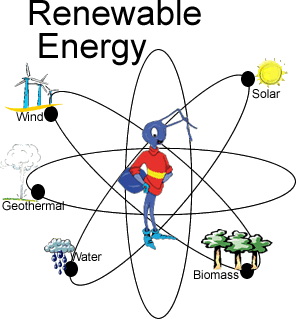Renewable Energy For Dummies
August 11, 2008 by Greener Buyer · 4 Comments
What Exactly Is Renewable Energy?
2008 has been a pretty wild and productive year as far as energy goes, as we have a pretty big problem right now, and no one seems to be able to agree on exactly how to solve it. Luckily, we do have some options on the table, and after all the smoke and dust clears, perhaps we can figure out which method(s) are most economical and most efficient. I’m speaking of renewable energy, which is quite different than fossil fuels in one main and obvious regard – we can renew it (hence the name renewable energy).
 Currently, there are five viable sources of renewable energy that we as humans can take advantage of, and a short description of each:
Currently, there are five viable sources of renewable energy that we as humans can take advantage of, and a short description of each:
1. Solar Energy – Ah, the power of the sun. Unless you’ve lived in a cave all of your life, you probably have a good idea that solar energy is energy collected from the sun and used later for electricity and heating. Obviously the sun is quite large, and in most parts of the world, you can collect a rather large amount of solar energy assuming you have the equipment. The technology required to harness the sun’s energy is getting less expensive by the year, and it’s a viable alternative source that we must consider taking advantage of if we want to live to see 50 years from now. More individuals and even business owners are taking advantage of it these days to fight the skyrocketing costs of electricity bills, and of course, for the tax benefits.
2. Geothermal Power – If you weren’t aware, we have this really hot thing in the middle of the Earth. It’s called the “core”. Anyway, deep inside the Earth, there are all sorts of things going on, and the one we’re most interested in is the heat. There is more than an abundance of natural heat down there, and when we harness and utilize that heat for energy, that form of energy is called Geothermal energy. More and more these days, homes and businesses are using geothermal heating systems to save on energy bills and to do their part in “going green”. Geothermal is actually a really great form of energy, since it doesn’t produce any pollution or greenhouse gases, but the only drawback is the initial cost to install the equipment to harness it. Not to mention, you have to live in a place that has the right geological properties in order to use it.
3. Wind Power – Wind energy is another one of those renewable sources that is very, very environmentally friendly, and actually has been used for quite some time. Generating electricity from wind is pretty straight forward – basically, electricity is produced when wind blows a massive turbine that spins to create the electricity. The equipment is somewhat expensive still, but over the course of the next ten years or so, that may change. One other drawback is that if it isn’t windy outside, then guess what – no wind, no power. Luckily, battery technology is very good in that turbines can store energy for days that have less wind than others.
4. Hydro Power – Another widely used source of renewable energy, hydro power is harnessed by using the flow of water to move turbines to create electricity. Water has been used for quite some time to make electricity, but died out a bit when fossil fuels became more popular. However, hydro energy is still used today, with about 7% of the energy in the US being powered by hydro electric power plants. Hydro power plants are typically found on large bodies of water (like big rivers), so geographically, you’ll only find them in states that can support them. Again, as technology develops, we’ll probably see a more widespread use of hydro power in the future, as it is a clean burning and natural way to power homes and businesses.
5. Bio Energy – Creating energy from plants and grains seems to be all the rage these days. Biodiesel, corn gasoline, and other forms of bio energy are being utilized all over the place to help combat out of control gas prices. Ethanol, which is basically gas made from corn, is widely used to power vehicles, and costs quite a bit less than regular gas. Many manufacturers are crating ethanol ready cars and trucks, and consumers seem to buy them more and more. There are all sorts of grains, plants and other naturally occurring gifts from Mother Nature that we can use to create different forms of bio energy, and as we move into the future, don’t be surprised if by the year 2020, you’re powering your car on carrots and beans.







